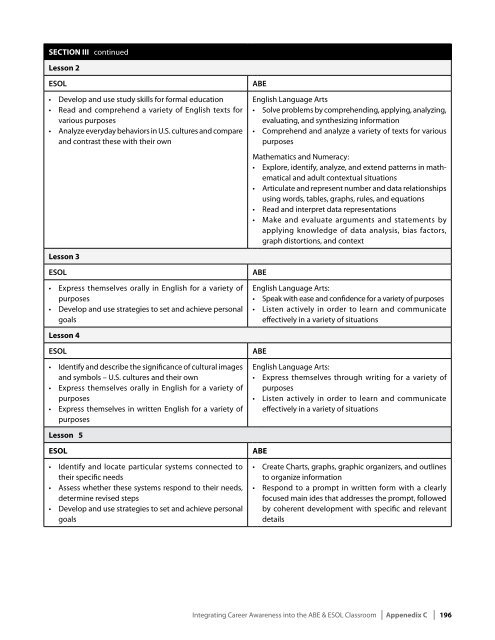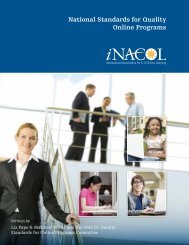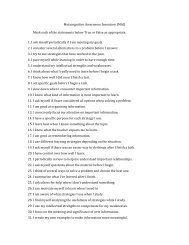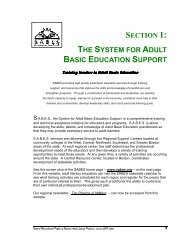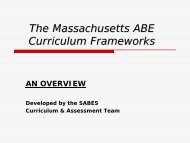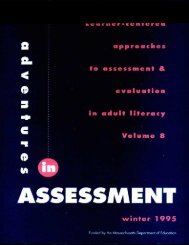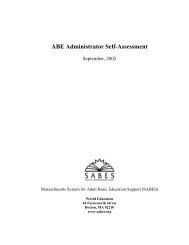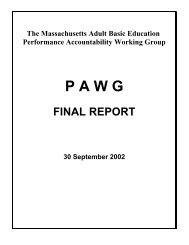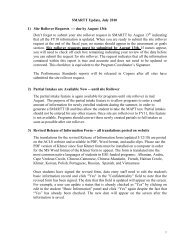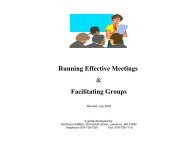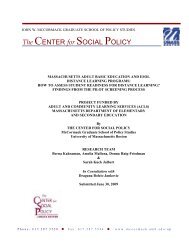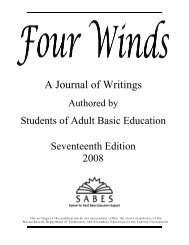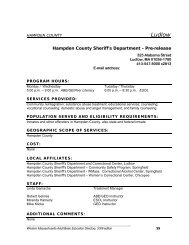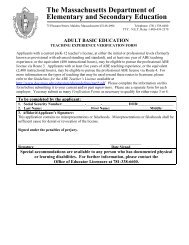Integrating Career Awareness into the ABE/ESOL Classroom - SABES
Integrating Career Awareness into the ABE/ESOL Classroom - SABES
Integrating Career Awareness into the ABE/ESOL Classroom - SABES
- No tags were found...
You also want an ePaper? Increase the reach of your titles
YUMPU automatically turns print PDFs into web optimized ePapers that Google loves.
SECTION III continued<br />
Lesson 2<br />
<strong>ESOL</strong><br />
• Develop and use study skills for formal education<br />
• Read and comprehend a variety of English texts for<br />
various purposes<br />
• Analyze everyday behaviors in U.S. cultures and compare<br />
and contrast <strong>the</strong>se with <strong>the</strong>ir own<br />
<strong>ABE</strong><br />
English Language Arts<br />
• Solve problems by comprehending, applying, analyzing,<br />
evaluating, and syn<strong>the</strong>sizing information<br />
• Comprehend and analyze a variety of texts for various<br />
purposes<br />
Ma<strong>the</strong>matics and Numeracy:<br />
• Explore, identify, analyze, and extend patterns in ma<strong>the</strong>matical<br />
and adult contextual situations<br />
• Articulate and represent number and data relationships<br />
using words, tables, graphs, rules, and equations<br />
• Read and interpret data representations<br />
• Make and evaluate arguments and statements by<br />
applying knowledge of data analysis, bias factors,<br />
graph distortions, and context<br />
Lesson 3<br />
<strong>ESOL</strong><br />
• Express <strong>the</strong>mselves orally in English for a variety of<br />
purposes<br />
• Develop and use strategies to set and achieve personal<br />
goals<br />
<strong>ABE</strong><br />
English Language Arts:<br />
• Speak with ease and confidence for a variety of purposes<br />
• Listen actively in order to learn and communicate<br />
effectively in a variety of situations<br />
Lesson 4<br />
<strong>ESOL</strong><br />
• Identify and describe <strong>the</strong> significance of cultural images<br />
and symbols – U.S. cultures and <strong>the</strong>ir own<br />
• Express <strong>the</strong>mselves orally in English for a variety of<br />
purposes<br />
• Express <strong>the</strong>mselves in written English for a variety of<br />
purposes<br />
<strong>ABE</strong><br />
English Language Arts:<br />
• Express <strong>the</strong>mselves through writing for a variety of<br />
purposes<br />
• Listen actively in order to learn and communicate<br />
effectively in a variety of situations<br />
Lesson 5<br />
<strong>ESOL</strong><br />
• Identify and locate particular systems connected to<br />
<strong>the</strong>ir specific needs<br />
• Assess whe<strong>the</strong>r <strong>the</strong>se systems respond to <strong>the</strong>ir needs,<br />
determine revised steps<br />
• Develop and use strategies to set and achieve personal<br />
goals<br />
<strong>ABE</strong><br />
• Create Charts, graphs, graphic organizers, and outlines<br />
to organize information<br />
• Respond to a prompt in written form with a clearly<br />
focused main ides that addresses <strong>the</strong> prompt, followed<br />
by coherent development with specific and relevant<br />
details<br />
<strong>Integrating</strong> <strong>Career</strong> <strong>Awareness</strong> <strong>into</strong> <strong>the</strong> <strong>ABE</strong> & <strong>ESOL</strong> <strong>Classroom</strong> | Appenedix C | 196


